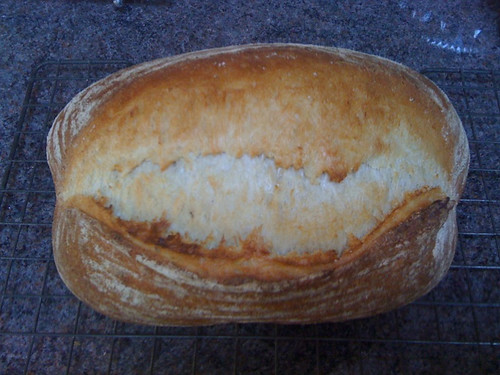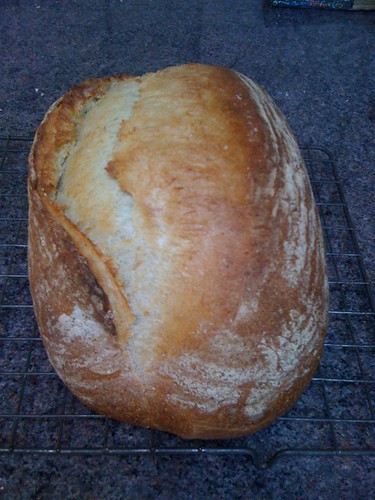So my bannetons arrived this morning...
If I'd known that I was going to get as obsessed with baking bread when I first started, I'd have been more scrupulous about recording and documenting what I was doing. As it was, I just kind of fell into it.I've been somewhat interested in sourdough for a couple of years now. By which I mean I'd read the FAQ, and toyed with the idea of baking it, but I never really did anything about it.
Then two things happened. Nigel Brunton posted on Facebook about how he had a sourdough loaf about to go into the oven -- and so I had a conversation with Nigel about how I've been thinking about doing it. And secondly, my wife Gerry got a starter going and baked her first loaf.
That loaf came out well. By which I mean that it rose well, and the crust and crumb were both acceptable. But it didn't really taste like sourdough.
And the more I read about it, the more it seemed it didn't look or taste like sourdough either.
Like many men, I'm obnoxious in my treatment of women. If a woman does X, I'm inclined towards saying, 'Well yeah, that's kind of OK but you should have done X, Y and Z. Then it would have been *really* good.'
Like most men, mostly I'll just gripe and moan and issue instructions as to how to improve something. But every now and again, I'm inclined to *show* them how it's supposed to be done if you're going to do the thing properly.
Somehow, sourdough baking fell into this last category.
When it came to baking the second loaf, I'd read a pile of introductory recipes on the net. And the second loaf was definitely an improvement on the first. But the more I read, the more I knew, the more dissatisfied I was with my loaf. I could see that it wasn't enough to just bake the damn thing. You needed paraphernalia to do this thing properly. And if there's one thing that a man likes, it's paraphernalia. Or as we normally refer to them -- toys.
Over the past few weeks, I've spent a pile of money on all manner of baking stuff. A cast iron casserole dish for making No Knead bread (a disappointing failure.) A granite counter-top protector to use as an oven stone and the old wood and coal fire oven (a great success -- that produced the 'oven spring' my bread had been lacking up until that point.)
As I said, I've had the crust and crumb sorted out for some time now. What my loaves were really lacking was aesthetic appeal. I was forming batards by hand, and doing my second prove in an old floured tea-towel. The taste was usually fine, but they tended to look awful. A peculiar shapeless mass.
And the other thing that I didn't seem able to master was the 'grigne' -- that wonderful effect that happens when you slash a loaf and the loaf rises in a controlled manner to form that striated effect, along with the bit that the French refer to as 'the ear' -- that flap of dough at the slash that tends to become the darkest part of the loaf.
Slashing is a crucial part of artisan bread, not only because the controlled bloom looks so great, but it's a critical part of how you shape a loaf.
Unfortunately, because of the high hydration levels of the dough I've been mixing, my attempts to slash the loaf tended to drag and make an unsightly edge, and allows all of the air to go out of the dough, leaving me with a floppy mess. I had been thinking that in order to get the kind of slashes that I wanted, I'd need to buy an expensive lame -- Mure and Peyrot do a lovely plastic razor blade holder for a tenner -- how could I possibly go wrong with such a thing?
But I've been experimenting with longer proving times -- refrigerating the dough overnight during bulk fermentation, and refrigerating the formed loaf for a few hours in order to improve flavour. I noticed that if I used a serrated knife on a loaf after it had come out of the fridge, I was able to slash it in exactly the ways I'd been trying and failing at when the dough was at higher temperatures.
And if I underproved the dough slightly before putting it in the fridge for the second retarded prove, I also got a much improved oven spring. These two factors, when combined together, got me far closer to my goal of making the perfect artisan loaf.
But the thing that seems to have made the most difference was the purchase of my bannetons. Every time I read a recipe, or watch a little breadmaking clip on YouTube, the baker always has a banneton or a brotform that they use to shape their loaves. I couldn't help but think that they were contributing more than just that pretty spiral pattern on the loaf. And bakers are notoriously stingy. It's hard to imagine that they'd be spending twelve quid on a proving basket if it didn't have a significant impact in some way.
Well, you can judge for yourself. But I'm really impressed. My loaves appear to have made a step up to the next level.
Twelve quid well spent.


No comments:
Post a Comment